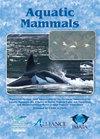浅水区白鲸回声定位声的变异性
IF 0.9
4区 生物学
Q4 MARINE & FRESHWATER BIOLOGY
引用次数: 0
摘要
虽然回声定位对齿螈的感官生态至关重要,但我们对大多数物种的信号特征的数据很少,这限制了我们对这些动物关键属性的理解,特别是对那些栖息地多样化的动物。白鲸(Delphinapterus leucas)已经成功地克服了生活在浅水和深水开放水域栖息地的压力。在美国阿拉斯加布里斯托尔湾,我们对13只野生白鲸在临时捕获和释放事件中的回声定位咔嚓声进行了表征。我们从大约22小时的录音中提取并检查了556次高质量的点击。作为一个组,持续时间(41.1±17.3µs;平均±SD)、峰值频率(97.9±34.4 kHz)、质心频率(101.9±23.9 kHz)、-3 dB带宽(29.1±14.4 kHz)、-10 dB带宽(67.7±31.8 kHz)和均方根(RMS)带宽(27.8±8.1 kHz)进行评估。这是野生白鲸在其自然浅水栖息地1米范围内的第一个轴上数据。白鲸在极浅的水域发出高频率和高来源水平的咔嚓声,而不顾潜在的强烈回响和杂乱。这些结果为未来研究该物种如何操纵其声纳在具有声学挑战性的浅水中成功操作提供了基础。本文章由计算机程序翻译,如有差异,请以英文原文为准。
Variability of Echolocation Clicks in Beluga Whales (Delphinapterus leucas) Within Shallow Waters
While echolocation is vital to the sensory ecology of odontocetes, we have few data characterizing the signals of most species, limiting our understanding of key attributes of these animals, especially for those with a diverse range of habitats. Beluga whales (Delphinapterus leucas) have successfully overcome the pressures of living in both shallow and deep open water habitats. We characterized the echolocation clicks of 13 wild beluga whales during temporary capture-and-release events in Bristol Bay, Alaska (USA). We extracted and examined 556 high-quality clicks from approximately 22 hours of recordings. As a group, the duration (41.1 ± 17.3 µs; mean ± SD), peak frequency (97.9 ± 34.4 kHz), centroid frequency (101.9 ± 23.9 kHz), -3 dB bandwidth (29.1 ± 14.4 kHz), -10 dB bandwidth (67.7 ± 31.8 kHz), and root mean square (RMS) bandwidth (27.8 ± 8.1 kHz) were assessed. These are the first on-axis data from wild belugas in their natural shallow water habitat within 1 m. Beluga whales emit clicks with high frequency and high source level in extremely shallow waters regardless of the potential strong reverberations and clutter. These results provide a foundation for future studies on how this species manipulates its sonar to successfully operate in acoustically challenging shallow waters.
求助全文
通过发布文献求助,成功后即可免费获取论文全文。
去求助
来源期刊

Aquatic Mammals
MARINE & FRESHWATER BIOLOGY-ZOOLOGY
CiteScore
1.60
自引率
16.70%
发文量
99
审稿时长
>12 weeks
期刊介绍:
Aquatic Mammals is a peer-reviewed journal sponsored by the European Association for Aquatic Mammals (EAAM), the Alliance of Marine Mammal Parks and Aquariums (AMMPA), and the International Marine Animal Trainers’ Association (IMATA). Aquatic Mammals publishes articles related to marine mammals (whales, dolphins, seals, fur seals, sea lions, walrus, dugongs, manatees, sea otters, and polar bears). Topics of publication on both captive animals and wild marine mammals include aspects of husbandry; behavior; conservation; veterinary medicine; anatomy; physiology; training; population trends; and the effects of pollution, climate change, and noise.
 求助内容:
求助内容: 应助结果提醒方式:
应助结果提醒方式:


